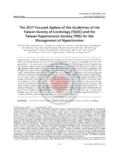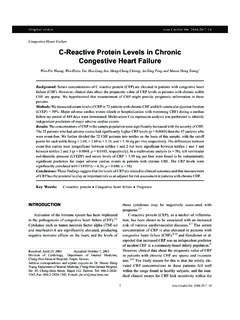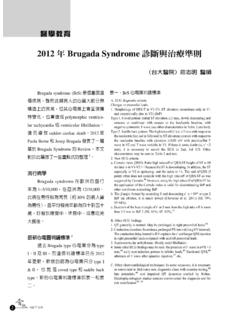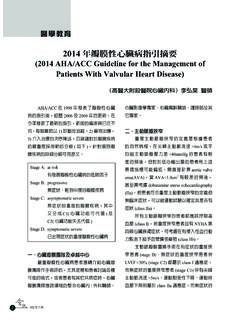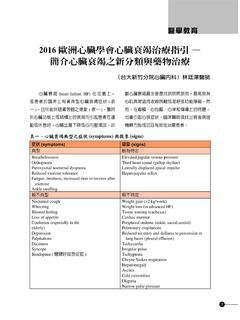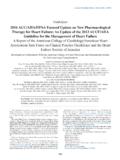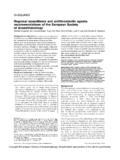Transcription of The 2017 Focused Update of the Guidelines of the Taiwan ...
1 The 2017 Focused Update of the Guidelines of theTaiwan society of cardiology (TSOC) and theTaiwan Hypertension society (THS) for theManagement of HypertensionChern-En Chiang,1 Tzung-Dau Wang,2 Tsung-Hsien Lin,3 Hung-I Yeh,4 Ping-Yen Liu,5 Hao-Min Cheng,6 Ting-Hsing Chao,7 Chen-Huan Chen,8 Kou-Gi Shyu,9 Kwo-Chang Ueng,10 Chung-Yin Chen,11 Pao-Hsien Chu,12 Shih-Hsien Sung,13 Kang-Ling Wang,14Yi-Heng Li,7 Kuo-Yang Wang,15Fu-Tien Chiang,16 Wen-Ter Lai,3,17 Jyh-Hong Chen,18 Wen-Jone Chen,2,19 San-Jou Yeh,20 Ming-Fong Chen,21 Shing-Jong Lin22and Jiunn-Lee Lin2 Hypertension (HT) is the most important risk factor for cardiovascular diseases. Over the past 25 years, the number ofindividuals with hypertension and the estimated associated deaths has increased substantially.
2 There have beengreat debates in the past few years on the blood pressure (BP) targets. The 2013 European society of Hypertensionand European society of cardiology HT Guidelines suggested a unified systolic BP target of 140 mmHg for bothhigh-risk and low-risk patients. The 2014 Joint National Committee report further raised the systolic BP targets to 150mmHg for those aged 60 years, including patients with stroke or coronary heart disease, and raised the systolic BPtarget to 140 mmHg for diabetes. Instead, the 2015 Hypertension Guidelines of the Taiwan society of cardiology andthe Taiwan Hypertension society suggested more aggressive BP targets of < 130/80 mmHg for patients with diabetes,coronary heart disease, chronic kidney disease withproteinuria, and atrial fibrillation patients on antithrombotictherapy.
3 Based on the main findings from the Systolic Blood Pressure Intervention Trial (SPRINT) and several recentmeta-analyses, the HT committee members of the Taiwan society of cardiology and the Taiwan Hypertension Societyconvened and finalized the revised BP targets for management of HT. We suggested a new systolic BP target to < 120mmHg for patients with coronary heart disease, chronic kidney disease with an eGFR of 20-60 ml/ m2, andelderly patients aged 75 years, using unattended automated office BP measurement. When traditional office BPmeasurement is applied, we suggested BP target of < 140/90 mmHg for elderly patients with an age 75 years. OtherBP targets with traditional office BP measurement remain unchanged.
4 With these more aggressive BP targets, it isforeseeable that the cardiovascular events will decrease substantially in Words: Guidelines Hypertension Taiwan Hypertension society Taiwan society of Cardiology213 Acta Cardiol Sin 2017;33:213-225 Review Articledoi: Cardiol Sin 2017;33:213-225 Received: April 14, 2017 Accepted: April 21, 20171 General Clinical Research Center, Division of cardiology , Taipei Veterans General Hospital and National Yang-Ming University;2 CardiovascularCenter and Division of cardiology , Department of Internal Medicine, National Taiwan University Hospital, Taipei;3 Division of cardiology ,Department of Internal Medicine, Kaohsiung Medical University Hospital, Faculty of Medicine, College of Medicine, Kaohsiung MedicalUniversity, Kaohsiung;4 Department of Medicine, Mackay Medical College, and Cardiovascular Division, Department of Internal Medicine,Mackay Memorial Hospital, New Taipei City;5 Division of cardiology , Department of Internal Medicine, National Cheng Kung University Hospital,and Institute of Clinical Medicine, College of Medicine, National Cheng Kung University, Tainan.
5 6 Department of Medical Education, TaipeiVeterans General Hospital and Department of Medicine and Institute of Public Health and Community Medicine Research Center, NationalYang-Ming University, Taipei;7 Department of Internal Medicine, National Cheng Kung University College of Medicine and Hospital, Tainan;8 Department of Medical Education, Taipei Veterans General Hospital, Department of Medicine, National Yang-Ming University School ofMedicine;9 Division of cardiology , Shin Kong Wu Ho-Su Memorial Hospital, Taipei;10 Department of Internal Medicine, School of Medicine,Chung-Shan Medical University Hospital;11 Division of cardiology , Kuang Tien General Hospital, Taichung;12 Division of cardiology , Department ofInternal Medicine; Heart Failure Center; Healthcare Center, Chang Gung Memorial Hospital, Chang Gung University College of Medicine;13 Division of cardiology , Taipei Veterans General Hospital and National Yang-Ming University;14 General Clinical Research Center, Taipei VeteransGeneral Hospital, School of Medicine, National Yang-Ming University, Taipei;15 Division of cardiology , Taichung Veterans General Hospital,Taichung;16Fu Jen Catholic University Hospital, New Taipei City;17 Kaohsiung Municipal United Hospital, Kaohsiung;18 Chollege of Medicine,China Medical University, Taichung;19 Division of cardiology , Poh-Ai Hospital, Yilan.
6 20 Department of Internal Medicine, Section of cardiology ,Chang Gung University Hospital College of Medicine, Chang Gung Memorial Hospital, Taoyuan;21 Cardiovascular Research Laboratory,Cardiovascular Center, Big Data Center, China Medical University Hospital, China Medical University, Taichung;22 Department of MedicalResearch, Taipei Veterans General Hospital, School of Medicine, National Yang-Ming University, Taipei, author: Dr. Chern-En Chiang, General Clinical Research Center, Department of Medical Research, Taipei Veterans GeneralHospital, No. 201, Section 2, Shih-Pai Road, Taipei 112, Taiwan . Tel: 886-2-2875-7774; Fax: 886-2-2874-5422; E-mail: is the number one killer in the 10 million people per year die from causes re-lated to hypertension, and elevated blood pressure (BP)is the most important modifiable risk factor for cardio-vascular (CV) a recent report from mil-lion participants in 154 countries,2it is estimated thatbetween 1990 and 2015 the rate of systolic BP (SBP) ofat least 110 to 115 mmHg increased from 73,119 to81,373 per 100,000 persons, and SBP of 140 mmHg orhigher increased from 17,307 to 20,526 per 100,000persons.
7 The estimated rate of annual deaths associatedwith SBP of at least 110 to 115 mmHg increased to per 100,000 persons, and for SBP of 140mmHg or higher increased from to per 100,000persons. Projections based on this sample suggestedthat in 2015, an estimated billion adults had SBP ofat least 110 to 115 mmHg and 874 million adults hadSBP of 140 mmHg or BP is especiallyimportant in Asia, for Asians having higher stroke ratecompared to other parts of the world, and SBP is themost important risk factor for BP targets for controlling hypertension are un-der great debate in recent decade. The reason for this isthat we have only a few target-driven randomized clini-cal trials (RCTs) to test one BP target versus the other.
8 Infact, before the Systolic Blood Pressure InterventionTrial (SPRINT),4we have only 2 large-scaled RCTs testingdifferent BP targets, namely the Action to Control Car-diovascular Risk in Diabetes (ACCORD) BP trial for SBPtargets in diabetic patients, and the Hypertension Opti-mal Treatment (HOT) study testing different diastolic BP(DBP) targets for more general patients. Other smallstudies did not have enough power to test the superior-ity of one target over the ,6 Under no confirming RCT to support the optimalSBP targets, the 2013 European society of Hypertensionand European society of cardiology (ESH/ESC) HT guide-lines suggested a unified SBP target of 140 mmHg forboth high risk and low risk patients, a loosening fromprevious 130 mmHg for high risk 2014 Joint National Committee (JNC) report further raised theSBP targets to 150 mmHg for those aged 60 years, in-cluding patients with stroke or coronary heart disease(CHD)
9 , and raised the SBP target to 140 mmHg for was a discrepancy in the panel meeting forthe 2014 JNC report, and 5 out of the 17 panel membersactually disagreed with the decision to raise SBP decision of the 2014 JNC report created tre-mendous the American society of Hy-pertension (ASH) HT Guidelines did not follow the 2014 JNC SPRINT TRIALThe SPRINT trial was funded by National Institute ofHealth (NIH) of total of 9,361 persons, aged 50years, with a SBP of 130 mmHg or higher and an in-creased CV risk were randomized to intensive treatmentgroup (SBP < 120 mmHg) or a standard treatment group(SBP < 140 mmHg). Four groups of patients were in-cluded: 1) clinical or subclinical CV diseaseother thanstroke; 2) chronic kidney disease (CKD), excluding poly-cystic kidney disease, with an estimated glomerular fil-trationrate(eGFR)of20tolessthan60ml/ ,calculated with the use of the four-variable Modificationof Diet in Renal Disease equation; 3) a 10-year risk of CVdisease of 15% or greater on the basis of the Framing-ham risk score; 4) an age of 75 years or older.
10 Patientswith diabetes mellitus or prior stroke were primary composite outcome was myocardial infarc-tion (MI), other acute coronary syndromes, stroke, heartfailure (HF), or death from CV unattended automated office BP (AOBP) (Table1) was used for the measurement of BP in the 1 year, the mean SBP was mmHg in theintensive treatment group and mmHg in thestandard-treatment group. After a median follow-up years, the trial was prematurely terminated owingto a significantly lower rate of the primary compositeoutcome in the intensive-treatment group than in thestandard-treatment group [ per year vs. year; hazard ratio (HR) ; 95% confidence inter-val (CI), to ; p < ]. All-cause mortalityActa Cardiol Sin 2017;33:213-225214 Chern-En Chiang et essential elements of AOBP (EMAU)EElectronic and automated deviceMMultiple readingsAAveraged meanUUnattended andundisturbed spaceswas also significantly lower in the intensive treatmentgroup (HR ; 95% CI, to ; p = ).
